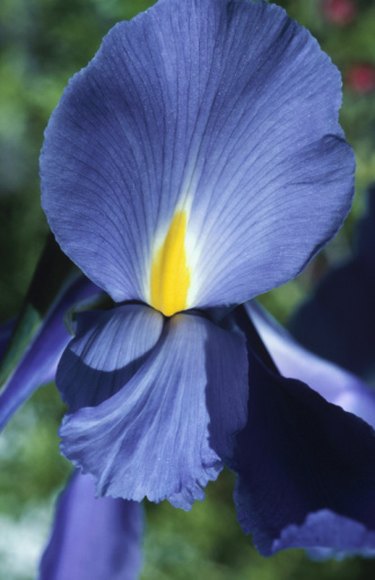
The gladiolus and the iris are both members of the Iridaceae family. These perennials are widely grown in home gardens and both make excellent cut flowers. They are, however, distinctly different flowers. Gladioluses, often called ''glads,'' bloom in the summer. Most varieties of irises, often referred to as ''flags,'' bloom in spring, but some varieties bloom in late winter or summer. Both have sword-shaped leaves on 2- to 4-foot stems and showy flowers.
Flower Structure
Video of the Day
The leaves of both gladiolus and iris are sword-shaped spikes, but the flower structure differs. The iris has three upward-growing petals called ''standards,'' and three downward-arching petals called ''falls.'' Each iris stem typically has one to six flowers blooming at a time. The gladiolus, on the other hand, has flaring trumpet-shaped flowers that cover most of the spiked stem. Both types of flowers come in many colors. The iris is available in true blue, but the gladiolus is not.
Video of the Day
Bulbs
Both the gladiolus and iris are loosely considered ''bulbs,'' because both grow from fleshy stem organs. Technically, gladioluses are corms. They are similar to bulbs, but the originial corm dies each year and is replaced by a new one. Small ''cormels'' form around the base of the corm. Irises can be corms, bulbs or rhizomes, depending on the variety. Rhizomes grow horizontally. The most well-known rhizome iris is the bearded iris.
Hardiness
Common gladiolus G. hortulanus and its cultivars are hardy in U.S. Department of Agriculture zones 8 to 10. Hardy gladiolus G. communis is hardy in zones 5 to 10. They should be planted in spring. Bearded irises I. germanica are hardy in zones 3 to 9. Most other varieties are hardy in zones 4 or 5 to 9. Irises should be planted in midsummer to early fall. Irises and gladioluses both grow best in full sun and look most attractive in mass plantings.
Overwintering
Most irises can survive freezing temperatures and return in the spring. You can only grow common glads, however, as annuals outside zones 8 to 10, or you can dig them up and replant annually. Dig the corms and cormels up in the fall and hang them to dry in a warm, dry place. When dry, remove and discard the old, withered corms. Dust with sulfur or another fungicide and store the new corms in a paper bag in a dark, dry, frost-free space over the winter. Replant in spring.